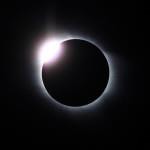7.2.7.2. Solar Eclipse

A solar eclipse will occur only when the Sun, the Earth and the Moon are in a straight line, and the Moon lies between the Sun and the Earth. This is possible on a New Moon day. But the solar eclipse does not occur on every New Moon day, as these three bodies have to be in the plane of ecliptic.
(a) If the Moon is exactly in the plane of ecliptic, a total solar eclipse will occur.
(b) If the Moon is close to the plane of ecliptic, a partial solar eclipse will occur.
(c) If the Moon is far above or far below the plane of ecliptic, no eclipse will occur.

The Diamond Ring Effect is a visual phenomenon that occurs during a total solar eclipse. It is seen from earth when standing in the umbra of the moon’s shadow, and occurs as a part of Baily’s Beads. Baily’s Beads are glimmers of the sun’s brilliant surface (the photosphere) which shine as dots of light around the disc of the lunar shadow. When only one “bead” remains, momentarily, the view of the eclipse resembles a diamond ring. The ring is produced as the sun’s less bright corona layer and other upper atmospheric structures remain dimly visible as a solid ring while a dazzling dot of
the photosphere shines at the edge.

